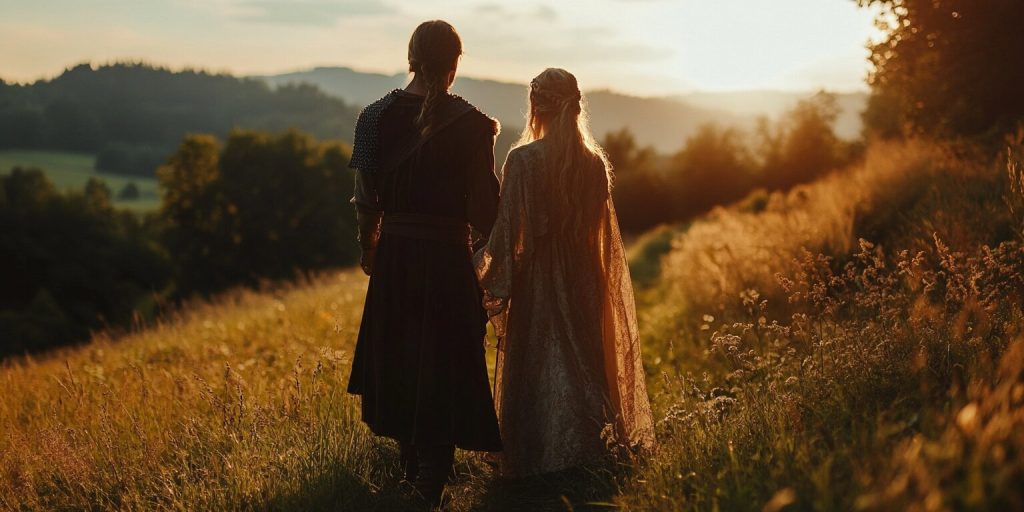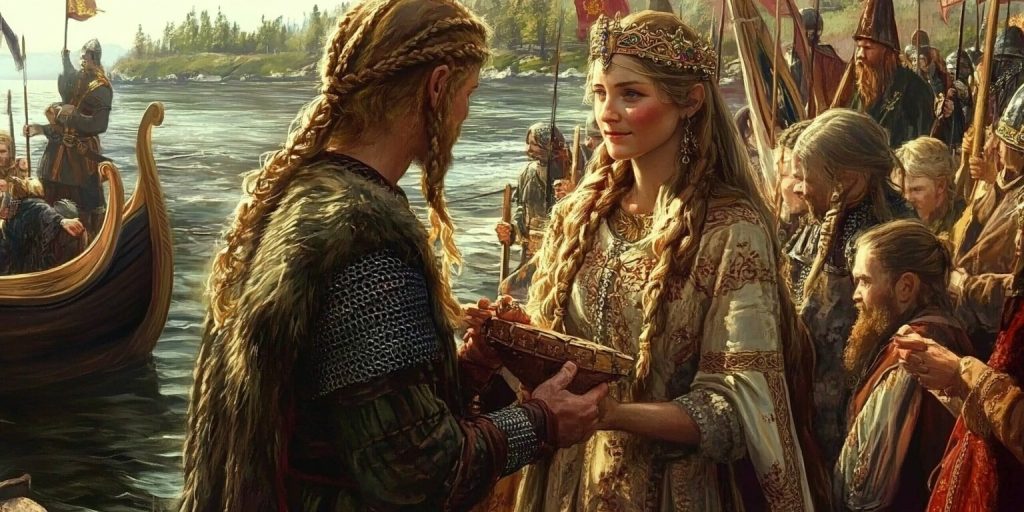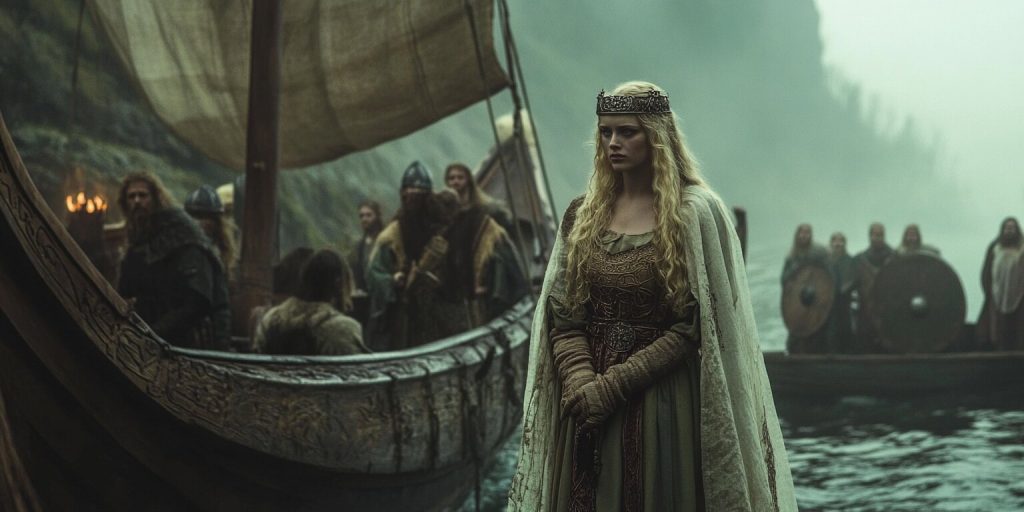Daily Life in the Viking Age, Vikings
What Was the Viking Dowry?
The Viking dowry was key in Norse tradition and important in Viking marriage customs. It showed the transfer of wealth and helped form alliances between families.
Exploring the dowry in Norse culture reveals its importance in Viking society. It shows how it affected marriage and social norms in the Viking Age. Learning about the Viking dowry helps us understand Viking relationships and values.
Introduction to the Viking Dowry
The viking dowry was key in Norse wedding traditions, often celebrated during the wedding feast. It was property, goods, or money the bride’s family gave to the groom. This helped the bride fit into her new family and strengthened family ties.
In Viking marriages, the dowry was more than money. It showed the bride’s family’s wealth and status. A big dowry made the bride more attractive, raising her family’s reputation.
Dowry expectations changed with region and clan, showing the variety in Norse wedding traditions. These customs were crucial for forming alliances and shaping social life. Knowing about the viking dowry helps us understand Viking culture and values.
The Concept of Dowry in Norse Culture
Dowry was very important in Norse culture, especially in the Viking Age. It included land, animals, and household items, which showed wealth and helped the bride’s family financially.
Dowries were more than just money; they often included valuable items like land rights and were integral to Viking-themed wedding celebrations. They made marriages official and helped families connect, which was key for building strong family ties.
Dowries were also a way for families to show their status. When families got together for marriage, dowries showed who was more important, helping families grow stronger together.
Dowry also had deep meaning in Norse culture. It showed how important marriage was for family and wealth and was often celebrated with a grand wedding feast. In the Viking Age, dowries showed the values of marriage and family.
Viking Marriage Traditions
The Vikings had rich wedding traditions. Dowry was key in Viking-age marriages, as it showed family commitment and economic strategy.
Role of Dowry in Viking Weddings
The dowry was crucial in Viking weddings. It showed the bride’s family’s commitment and the groom’s welcome, reinforcing the sacred nature of marriage in Viking culture. Families would discuss and agree on dowry terms before the wedding.
Common dowry items included:
- Property or livestock
- Land rights
- Household items
These items helped the couple’s economic stability and showed the joining of two families. The community often celebrated Dowry rituals, strengthening the marriage and honoring the bridal couple.
Historical Context of Viking Marriages
Viking marriages were often arranged. Social and economic factors played big roles. Dowries were vital in forming alliances between clans.

Families looked for matches that would boost their status and wealth. These factors shaped expectations for the bride and groom, including the significance of the bride price in Viking customs. Dowry was a big part of Viking marriage stories.
Significance of Dowry in Viking Society
In Viking society, dowry was key to family and social life. It showed a family’s wealth and status, helped families gain respect, and strengthened ties.
Dowries helped families work together, which was important in a world full of challenges. They ensured strong marriages and helped clans stay united, reflecting the importance of community in Viking-themed weddings.
Dowries showed how important family bonds were in Viking culture. They helped build strong communities and kept families loyal to each other.
The Process of Arranging a Viking Marriage
Viking marriages were arranged with family at the center. Fathers often led in talks about the dowry during the viking wedding ceremony. This ensured everyone agreed before the marriage was official, a practice rooted in pagan Nordic wedding traditions.
Family Involvement in Betrothal
Families were vital in the betrothal process, ensuring the groom would meet the expectations of both sides. Both sides had to agree for the marriage to be valid. They talked about the dowry, status, and the couple’s future, which are crucial elements of the wedding ceremonies.
This helped strengthen family bonds and create alliances.
Consultation and Agreements
Talks about marriage agreements were detailed. Parents worked out the dowry, a key part of Viking marriages. These talks led to contracts that protected the bride and groom’s rights.
This careful planning aimed to secure a good future for the couple.
Viking Dowry and Family Alliances
The dowry was key in forming family alliances in Viking society. It was more than just a deal; it was a way to build strong economic and political ties. Through marriage, families could boost their social status and gain valuable resources, enhancing love and marriage.
Families used dowries to strengthen their bonds, much like the traditions of Viking women, who played vital roles in these unions. For example, a dowry for a daughter might include livestock, land, or valuable items. These gifts were about wealth and gaining control over resources, which changed how families handled inheritance and property rights.
- Dowries helped families keep power during disputes over who should inherit.
- The economic ties from these marriages affected more than just family, intertwining their fates in a saga of love and marriage. They changed how communities worked together.
- Families would often bargain over dowries to marry their daughters into powerful families. This helped keep their status strong.
Using dowries wisely helped Viking families build lasting relationships. This created a network of dependence that was the backbone of Viking society, as highlighted in their sagas.
Impacts of Dowry on Viking Marriage Ceremony
The dowry effect was key in Viking marriage ceremonies, reflecting how marriage was a sacred bond in Viking culture. It set the scale and expectations of the event. Guests looked forward to big celebrations if there was a big dowry, showing wealth and status.
The ceremony’s structure changed based on the dowry’s size. The bride’s family would show off their dowry, showing their social standing. This led to different rituals, from simple gatherings to big feasts.
- The dowry made family exchanges in ceremonies more important.
- Wedding impacts were seen in talks before the marriage. Terms and amounts set the family relationships, as depicted in ancient sagas.
- The bride and groom were seen as symbols of their families’ unity thanks to the dowry.
In Viking history, dowries made weddings more than just about two people. They showed the importance of family ties and wealth in Viking society.
Viking Marriage and Women’s Rights
The role of women in Viking marriage is complex. They were not just tools for making alliances. Women had rights and power, especially in marriage. Dowries played a big role in this.
Position of Women in Viking Marriages
Women in Viking marriages were more than just for family lines. They managed homes and made important family decisions. Their roles varied based on social status and personal situations. This shows how important women’s rights were in Viking society, particularly during the wedding ceremonies.
Marriage Contracts and Female Agency
Marriage contracts in Viking culture protected women’s rights, ensuring that Viking women had a voice in their marital arrangements. They recognized women’s value to family wealth and power, showing that women had more control than in many other times.
These contracts helped women negotiate their roles in marriage and gave them legal support and power in their partnerships.
Typical Elements of a Viking Wedding
Viking weddings were full of tradition and meaning. They showed the values and beliefs of Norse culture. These ceremonies brought people together and honored the gods.

Viking Wedding Rituals and Customs
The Vikings had special wedding rituals. The celebration started with vows, showing the couple’s commitment. Then, the handfasting ceremony tied their hands together, symbolizing their bond.
Feasting was a big part of the celebration. Guests enjoyed roasted meats, bread, and mead at the wedding feast. This showed community support and happiness. Gifts were also shared, bringing everyone closer together.
- Divine blessings were sought through rituals involving offerings to gods and ancestors.
- Music and storytelling featured prominently, with guests recounting tales of valor and love.
- Engagement of the community in toasts aimed at wishing the couple prosperity and fertility.
These rituals were more than just formalities. They showed the heart of Viking life. They mixed personal and community spirit, demonstrating the importance of tradition and community support.
Comparing Viking and Modern Wedding Traditions
Viking and modern wedding traditions show a rich mix of practices around marriage. Both traditions value family and commitment, but they differ in their customs. These differences help us see how marriage values have changed over time.
In Viking culture, dowry was key in marriage deals. Families would agree on dowry, showing clan alliances. Today, couples focus on love and partnership, not just family ties.
Viking weddings involved big gatherings with community rituals. This brought people together, creating a sense of belonging in the community during the viking wedding ceremony. Now, weddings are more personal, with unique themes and touches. This shift reflects the change from Viking to modern times.
Wedding rituals have also changed, but the essence of Viking-themed weddings is often drawn from ancient practices. Vikings had many traditional practices, showing their culture and beliefs. Modern weddings mix traditions from many cultures. This mix shows how weddings have evolved over time and across cultures.
Even though Viking and modern weddings celebrate union, they show different societal norms. Looking at these traditions helps us appreciate the meaning behind today’s wedding rituals.
Cultural Reflections of Viking Dowry
The dowry in Viking culture shows us how marriage and family were seen. It shows how wealth was key in partnerships, particularly in the context of Viking-themed weddings. This exchange showed a family’s status and the roles of men and women.
In Viking society, dowries showed the value of women in marriage. A woman’s worth was tied to the gifts she brought. This practice showed the importance of family alliances and marriage beyond personal love.
- Dowries helped families connect and strengthen their bonds.
- They showed the economic side of marriage, setting expectations.
- Today, we still see echoes of Viking dowry customs in Scandinavian weddings.
Dowries in Viking marriages still matter today. They make us think about how society affects our views on marriage. Looking at old customs helps us understand changes in gender roles and marriage values.
Conclusion
In this summary of Viking dowry, we’ve examined how dowries were key in Viking marriages, emphasizing the importance of marriage in Viking society. Dowries helped shape personal relationships and society as a whole. They were also important for building alliances and displaying family status, showing how ties were crucial in Norse culture.
Viking marriages were a mix of practicality and deep culture, focusing on dowries as a wealth transfer. These Nordic wedding traditions were more than deals; they helped create strong bonds in Viking society. Through these unions, families came together, leading to a rich mix of marital duties and expectations.
In our final thoughts on Viking tradition, dowry’s impact goes beyond just weddings. These customs have shaped family structures and social norms, keeping a cultural identity alive. By exploring Viking dowry and its role in marriages, we see the lasting impact of this civilization.

